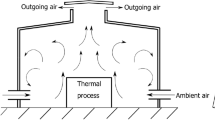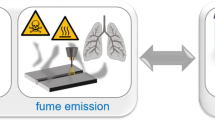Abstract
The Econweld Project identified the development of a lightweight and ergonomic fume extraction GMAW torch as a high priority research need. This report has been completed in response to this need. At source, capture is the most efficient method for eliminating welding fumes from the metalworking environment, particularly from the breathing zone of the welder. Worker productivity can increase by up to 20% when an integral suction torch is installed in a welding fabrication shop, resulting in less sick leave taken by welders and improved employee morale. Moreover, significant energy savings can be achieved when source capture is used compared to general ventilation methods. The state-of-the-art of existing fume extraction torches and requirements for improving torch performance have been analysed, considering the weight, flexibility and fume extraction capability, with particular emphasis on the integral extraction torch adopted by the EC-funded Econweld Project. Through a historical survey of the evolution of integral suction torches, the recent methods for evaluating their capture efficiency have been analysed, the early developments of fume extraction torches have been reviewed and the more effective improvements in commercial torches have been investigated, both for their increasing efficiency and enhanced ergonomic assessment. The modern Computational Fluid Dynamics (CFD) approach has been briefly described, in order to model the fume plume dispersal and capture efficiency, with results validated by prestigious scientific institutions.
Similar content being viewed by others
References
EC funded Collective Research Project, Contract N. CT-2005–516336, Economically welding in a healthy way (Econweld) — Project website: http://www.ewf.be/econweld/.
Escala S., Nooij M., Quintino L.: Economically welding in a healthy way, EWF Document, 1st South East European Welding Congress, Timisoara, Romania, May 2006, pp. 244–251. Download at: www.efw.be/media/publications/A22.pdf.
Aspirmig Srl, Turin, Italy — Download at: www.aspirmig.com.
Caruggi M., Nilberto A.: Welding investigation and optimisation by means of Computational Fluid Dynamics, IIW Doc. VIII-2041–07, International Institute of Welding, 2007.
Colombo F.: Ergonomics in welding: experimental results in industrial cases, IIW Doc. VIII-2040–07, 2007.
Srinivas S.D., Mukund K., Arun M.: Computational modelling and simulation of Buoyant Plume Dynamics, 2nd International Congress on Computational Mechanics and Simulation (ICCMS), 2006, Coimbatore, India.
Fiore S.R.: Reducing exposure to Hexavalent Chromium in Welding Fumes, Welding Journal, August 2006, vol. 85, no. 8, pp. 38–42.
American Conference of Governmental Industrial Hygienists (ACGIH), Industrial Ventilation — A Manual of Recommended Practice, 2nd Edition, 1995, Cincinnati (USA).
Brandt A.: Industrial Health Engineering, John Wiley & Sons, 1947, New York (USA), pp. 71.
Olander L., Conroy L., Kulmala I., Garrison R.: Industrial ventilation — Design guidebook, vol. 1, Chapter 10, Academic Press, 2001, San Diego (USA), pp. 809–1022.
EN ISO 15012–1:2004, Health and safety in welding and allied processes — Requirements testing and marking of equipment for air filtration — Part 1: Testing of the separation efficiency for welding fume.
EN ISO 15012–2:2008. Health and safety in welding and allied processes — Requirements, testing and marking of equipment for air filtration — Part 2: Determination of the minimum air volume flow rate of captor hoods and nozzles.
prEN ISO 15012–3:2006. Health and safety in welding and allied processes — Requirements, testing and marking of equipment for air filtration — Part 3: Determination of the capture efficiency of welding fume extraction devices using tracer gas.
Schlüter J.: Welding torch, International Application, Patent no. US 4,284,873, August 1981.
Troyer W. E., Wildenthaler L. F.: Fume extracting welding gun nozzle, International Application, Patent no. US 3,798,409, March 1974.
Mann R.N.: Nozzle structure in welding gun, International Application, Patent no. US 5,015,822, May 1991.
Knoll B., Moon A.M.M.: Welding torch with inverse extraction, International Application, Patent no. US 6,380,515, April 2002.
Cooper P., Godbole A., Norrish J.: Apparatus and method for welding, International Application, Patent no. WO 2007/106925 A1, September 2007.
Berufsgenossenschaftliches Institut für Arbeitsschutz — BIA: Focus on BIA’s work. N.: 0150 — Welding fume extraction devices — Requirements and standardization, Sankt Augustin, Germany, 11/2003.
Marsteau S.: Fumées de soudage — Evaluation des équipments de traitement des gaz, Welding fumes — Assessment of gas treatment equipment, Cahier de notes documentaires de I’INRS (France), 2007, ND 2264, no. 206, pp. 29–38 (in French).
Cornu J.C., Muller J.P., Guélin J.C.: Torches aspirantes de soudage MIG/MAG — Méthode de mesure de l’efficacité de captage — Etude de paramètres d’influence, MIG-MAG welding torches with fume exhaust devices — Exhaust efficiency measurement method — Study of relevant parameters, Cahier de notes documentaires de l’INRS (France), 1991, no. 145, pp. 663–669 (in French).
Wildenthaler L., Cary H.B.: A progress report on fume extracting system for gas metal arc welding unit, Welding Journal, September 1971, pp. 623–635.
Wiehe A.E., Cary H., Wildenthaler L.: Application of a smoke extracting system for continuous electrode welding, Welding Journal, June 1974, pp. 349–361.
Kollman K.G.: Solving the problem of GMAW fume extraction, Welding Journal, August 1973, pp. 504–508.
Welding gun also extracts smoke, Canadian Welder and Fabricator, May 1972, pp. 32–33.
The GMA smoke extracting gun, Welding Journal, June 1972, vol. 51, no. 6, pp. 419–420.
Head I.W.: Integral fume extraction in MIG/CO2 welding, Metal Construction, December 1979, pp. 633–638.
Aastrup P.: Influence of MIG-gun fume extraction systems on concentration of welding fume, concentration of ozone and optical radiation, Danish Welding Institute Report (Svejsecentralen) 30.1.78. Contribution to GSP 5510. The Welding Institute, Doc. No. 5510/29.
Wangenen H.D.V.: Assessment of selected control techniques for welding fumes, NIOSH report no. 79–125, January 1979.
Wright R.R.: Fume removal for semi-automatic welding, International Conference on Exploiting Welding in Production Technology, The Welding Institute, London, April 1975, pp. 109–117.
Perrault G., Lazure L., Nguyen V.H., Létourneu C.: Efficacité du captage des fumées de soudage par les torches aspirantes de type MIG-MAG, Welding-Fume collection effiency of MIG-MAG aspirating welding guns, Rapport de recherche R-073, IRSST, Québec, Janvier 1993, 12 p.
Nguyen V.H., Normand M.C., Huot L., Lazure L., Létourneau C.: Évaluation biomécanique de différents pistolets de soudure, Biomechanical evaluation of different welding guns, Rapport de recherche, IRSST, Québec, Oct. 1990 (in French).
Nguyen V.H., Létourneu C.: Ventilation par extraction à la source: les pistolets de type MAG et MIG, Ventilation by at source extraction: MAG and MIG welding guns, Rapport de recherche, IRSST, Québec, 1990, 20 p. (in French).
Yapp D., Lawmon J., Castner H.: Development of lightweight fume extraction welding gun, National Shipbuilding Research Program SP-7 Final Report, Edison Welding Institute, May 2001, 46 p.
AWS Standard F1.2, Laboratory Method for Measuring Fume Generation Rates and Total Fume Emission of Welding and Allied Processes, 1999.
AIAA Guide for the verification and validation of computational fluid dynamics simulations. AIAA G-077–1998, American Institute of Aeronautics and Astronautics, Cleveland, Ohio (USA).
Saito H., Ojima J., Takaya M., Iwasaki T., Hisanaga N., Tanaka S., Arito H.: Laboratory measurement of hazardous fumes and gases at a point corresponding to breathing zone of welder during a CO2 arc welding, Industrial Health, 2000, vol. 38, no. 1, pp. 69–78.
Ojima J., Shibata N., Iwasaki T.: Laboratory evaluation of welder’s exposure and efficiency of air duct ventilation for welding work in a confined space, Industrial Health, 2000, vol. 38, no. 1, pp. 24–29.
Ojima J.: Performance of a fume-exhaust gun system in CO2 arc welding, Journal of Occupational Health, 2006, no. 48, pp. 207–209.
Iwasaki T., Fujishiro Y., Kubota Y., Ojima J., Shibata N.: Some engineering countermeasures to reduce exposure to welding fumes and gases avoiding occurrence of blowholes in welded material, Industrial Health, 2005, no. 43, pp. 351–357.
Sutherland R.A.: Exposure to fumes and gases during welding operations, Ph.D. Thesis, University of Deakin, Australia, 1998, 278 p.
Slater G.R.: Welding fume plume dispersion, Ph.D. Thesis, University of Wollongong, Australia, 2005, 225 p.
Cooper P., Hunt G.: Experimental investigation of impinging axisymmetric turbulent fountains, 15th Australasian Fluid mechanics Conference, Sydney, Australia, 13–17 December 2004.
Norrish J., Slater R., Cooper P.: Particulate fume plume distribution and breathing zone exposure in Gas Metal Arc Welding, International Conference on Health and Safety in Welding and Allied Processes, Copenhagen, 9–11 May 2005.
Godbole A., Cooper P., Norrish J.: Computational fluid dynamics analysis of on-torch welding fume extraction, Australasian Welding Journal, 2007, vol. 52, no. 35, pp. 34–42.
Cooper P., Godbole A., Norrish J.: Modelling and simulation of gas flows in arc welding — Implications for shielding efficiency and fume extraction, Soldagem Insp. São Paulo, Brasil, Oct/Dec. 2007, vol. 12, no. 4, pp. 336–345.
Wolf Robotics Inc., Columbus, Ohio — Form No. 1271–2, 2007 — Download at: www.rimrockcorp.com.
Author information
Authors and Affiliations
Corresponding authors
Additional information
“CAPTURE EFFICIENCY OF INTEGRAL FUME EXTRACTION TORCHES FOR GMA WELDING — PART 1” including sections 1 “Introduction” and 2 “Welding fume extraction torches”, was published in Welding in the World, vol. 54, Issue no. 1/2
Rights and permissions
About this article
Cite this article
Marconi, M., Bravaccini, A. Capture Efficiency of Integral Fume Extraction Torches for GMA Welding — Part 2. Weld World 54, 15–33 (2010). https://doi.org/10.1007/BF03263486
Published:
Issue Date:
DOI: https://doi.org/10.1007/BF03263486




